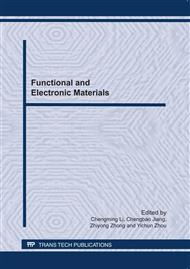p.354
p.359
p.366
p.370
p.375
p.380
p.385
p.391
p.396
Relaxation Behavior of Zr Substituted CaCu3Ti4O12 Ceramics
Abstract:
The dielectric properties of Zr substituted CaCu3Ti4O12 ceramics have been investigated in detail. Grain size decreases with Zr content increasing. The hetero-electrical microstructures of prepared samples have been confirmed by the impedance spectra. The dielectric loss has been improved by Zr doping because of the enhancement of grain boundary resistivity. A Debye-like boundary relaxation behavior has been observed in the temperature range of 220-600K. As Zr content increases, the relaxation time increases due to the higher grain boundary concentration. This work has provided an additional proof for the origin of giant dielectric response in CaCu3Ti4O12 ceramics.
Info:
Periodical:
Pages:
375-379
Citation:
Online since:
June 2011
Authors:
Keywords:
Price:
Сopyright:
© 2011 Trans Tech Publications Ltd. All Rights Reserved
Share:
Citation:


